
Kosuke Takahashi
Customer Experience Creative Center
Dentsu Inc.
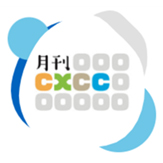
Monthly CX editorial team
Members from Customer Experience Creative Center (CXCC),
CX specialist team, deliver information about CX and creative as titled "Monthly CX".
In what way can Dentsu’s creatives contribute to the design of CX (customer experience), an area in high demand across various fields including advertising and marketing?
In this series of “Monthly CX”, members of Dentsu Customer Experience Creative Center (CXCC), CX specialist team, will take a close look at specific cases to search for the role and possibilities of creatives in the area of CX.
The second of the series will focus on award winning “Braille Neue”, braille that can be visually read. Kosuke Takahashi, who ‘invented’ Braille Neue, shared his thoughts on what the role of CX creative is.

Kosuke Takahashi
Customer Experience Creative Center (CXCC)
Dentsu Inc.
Born in Tokyo and raised in Akihabara, known by many as the center of modern Japanese pop culture.
Produces interactive content and creates signage plans for public facilities, while also playing an active role as an inventor.
Lifework is to pursue new areas through inventions, such as “Braille Neue”,
a font system combining printed characters and braille, and “Linkage”,
a universal communication game based on tactile signing (sign language using touch).
Notable awards received include Wired Audi Innovation Award, Index: Design Award, and Tokyo Midtown Award.
A universal font that merges printed characters that can be visually read and braille that is read with the touch of one’s fingers.
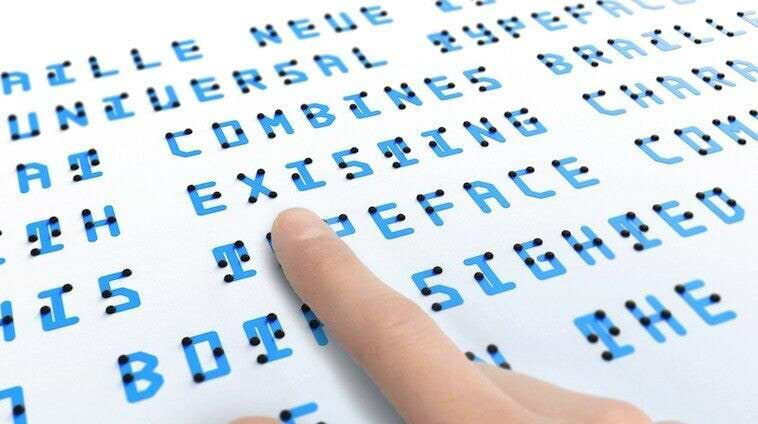

A miniscule thought, “This is interesting…” is the first step of an invention
Monthly CX: First of all, tell us briefly how “Braille Neue” was born.
Takahashi: I originally studied product design at university, and there were a lot of assignments we had to submit that were related to social issues. So I naturally developed an image that ‘design’ has to do with tackling social issues. I joined Dentsu and the first project I was asked to participate in was “NIN_NIN”, a robot that sits on people’s shoulders that was created to respond to the needs of people who are visually impaired. That led to my working with an elder Dentsu member to plan an event bringing together people with and without a visual impairment. That was the first time I actually saw a friend of mine reading braille. There were many new discoveries for me: “That’s how you read braille!” or “That’s how the braille system works!”
Monthly CX: It’s rare to actually watch people with a visual impairment reading braille and seeing how fast they can read.
Takahashi: You see braille at train stations and at various places in the city, but you rarely have a chance to see somebody reading braille. I was really curious and thought braille was very interesting. My friend told me, “You can learn to read braille too, then you can even read in the dark.” My curiosity was really stimulated.
But it seemed too difficult to learn how to read braille. I thought it would be helpful if there was something that could assist beginners, and that’s when an idea came to me: What if I drew lines connecting the dots of braille to form letters so it would be a little easier to read. So scribbling helped me come up with the idea for Braille Neue.
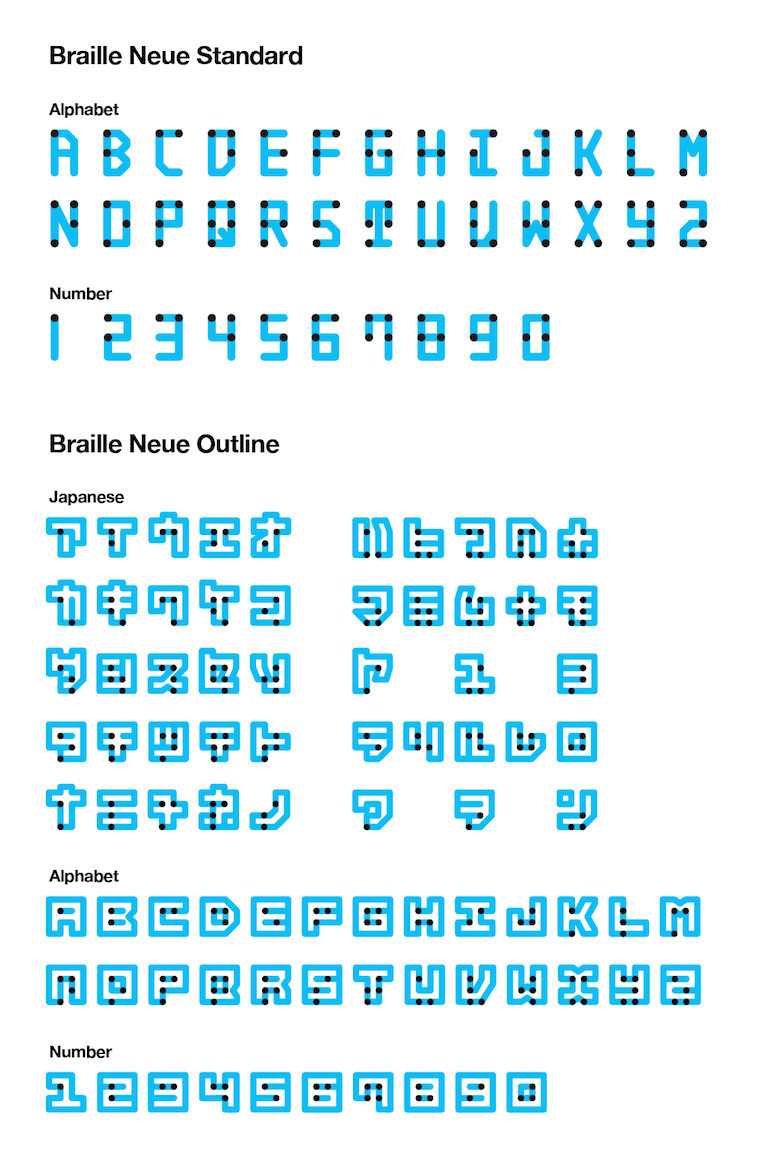
Takahashi: I brought this idea to an elder Dentsu member, and he suggested that we plan an event around it. We printed items using raised letters and graphics to create the event logo and the IDs for event participants that they wore around their neck.
I noticed a person with a visual impairment converse with a person who can read, and that’s when I realized that this special character system is a tool that connects people.
Monthly CX: A tool that connects people?
Takahashi: By using a common tool, the opportunity is presented to meet people you have never been involved with before.
I thought this might be meaningful… So I posted a tweet, and I got a lot of responses from different places. I looked for a partner that might be able to help develop a useful implementation for the tool, and I found Shibuya Ward, Tokyo.
Monthly CX: So the first partner was Shibuya Ward.
Takahashi: I went to give a presentation to the Mayor of Shibuya, and my idea was accepted on the spot. The Mayor said, “This is great. Let’s introduce this from Shibuya and spread it across the world!” I was introduced right away to the welfare department, and we started working on distributing the tool to facilities in Shibuya Ward.
Monthly CX: Wow, so it took off right away!
Takahashi: Of course, I spoke with many companies before that, but it wasn’t easy to bring it to the execution level. After the implementation in Shibuya, however, various companies expressed interest. Right now I am working with a visually impaired staff of a pharmaceutical firm to improve their in-house signage (directions put up in the company facilities) plan using Braille Neue.
Monthly CX: The way the tool is adopted widely through someone with a visual impairment is something unique to Braille Neue.
Takahashi: This project started with my curiosity about braille. I thought it was interesting and felt there was something there. When I developed my idea, the tool opened up a totally different world for me and I met people I never knew before. It was fun to experience how the tool opened new doors that I never could’ve imagined.

CX creative is someone who can focus on each person’s needs
Monthly CX: In this series we look at different examples to search the answer to the theme, “What is a CX creative?” Having received the Dentsu CX Award for the tool you invented, Braille Neue, what does the term ‘CX creative’ mean to you?
Takahashi: When I found out that I would be transferred to the CX Creative Division, I remember thinking, “Maybe at the CX Creative Division, it would be easier to pursue what I’m trying to explore.”
Monthly CX: Why is that?
Takahashi: My impression was that CX Creative is ‘closer to people’ than mass creative. The conventional mass advertising or digital advertising usually takes the ‘one versus the mass’ approach, targeting a huge group. Mass creative is based on the idea, “Let’s try to get all these people excited,” whereas CX creative felt like I could empathize with each person and respond to their personal needs.
Monthly CX: I see, so CX is focused not on the mass but on the needs of each individual.
Takahashi: Exactly. Let’s say you want to increase fans. You would imagine how each person would react. The means you use to increase fans are also diverse, and it includes ways that would find its way naturally into each person’s lives.
We have used the concept, ‘free to choose any means’ (selecting the appropriate communication means without constraints) before, but the main use has been mass advertising and digital was usually just a part of it. With CX creative, I feel that it’s okay to compete in an area where the main target is not the mass.

Monthly CX: What is it about Braille Neue that receives high points in terms of CX?
Takahashi: I’m not exactly sure why the tool received such attention in the area of CX, but if I were to give one reason, it could be because Braille Neue hacked the media of written characters.
Monthly CX: Media hack? Which particular aspect makes you say so?
Takahashi: One aspect is the ideology of written characters. I focused not only on its basic function to communicate information, but also on the role it plays in triggering communication. By merging characters for people who can read and characters for the visually impaired in a matter-of-fact way, I came up with a design that could provide new connections between people.
Another is the use of blank space. I left a blank space for clients using Braille Neue to think freely about how to use the tool. Characters are widely used as a tool to communicate information. By adding a role as a trigger to initiate communication and seeing the tool used naturally was a big accomplishment.
Monthly CX: A blank space for users to think about the usage.
Takahashi: For example, a fashion brand had an idea for clothes collaborating with Braille Neue, and proposed making clothes that can be ‘touched and felt’. Never before has braille received attention from the fashion industry, so this was a step forward to expand its range of application.
Monthly CX: It’s an expansion.
Takahashi: It was interesting to see how people who have never experienced it before become part of its current.
For instance, I once heard that people with a visual impairment are often alienated from fashion because they can’t see the color combinations so they end up choosing either black or white. At the same time, they also revealed that they feel good when they wear their favorite outfit. They said that if they could give a description of what they are wearing, it would be absolutely great.
Fashion is dominated by people who can see, but with the addition of a different essence like this, the market will slightly expand.
Monthly CX: People who have been alienated are joining the current of fashion. That is indeed ‘expanding the range’! What exactly is written on the Braille Neue clothes?
Takahashi: The usual brand name, or some have a poem about ‘a light in darkness’. I gave one to a friend, who encouraged people to touch the surface and told me that it triggered a lot of communication.
Monthly CX: What were some of the reactions of the people who experienced Braille Neue at the Shibuya Ward facilities?
Takahashi: The good thing about it was that we gained interest from people who can see. Our target is to have Braille Neue serve as a door through which people who can see can enter the world of people with a visual impairment.
Monthly CX: It’s interesting that you hacked the tool, braille, which is used by people with a visual impairment and ended up with reactions from people who can see. It’s mysteriously wonderful that both groups can obtain the same information from the same characters.
Takahashi: I hope to broaden the customer’s range a bit rather than elicit expansion in the CX journey map. I once learned of ‘tactile signing’ from a deafblind friend of mine. It’s a method of communication in sign language that also involves touching. That gave me an idea, and I created “Linkage”, a game played using one’s fingers. That was also a way to expand the range.
A simple game where wooden sticks are held between the players’ fingertips and players follow the instruction on the cards while they try not to drop the sticks.

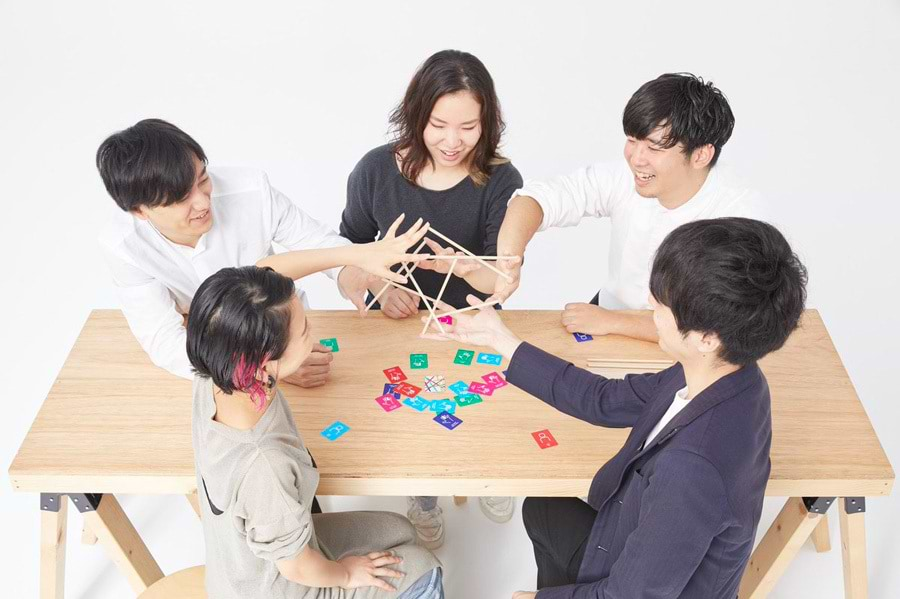
Monthly CX: Can you tell us more about it?
Takahashi: Sure. When I first met my deafblind friend, I thought, “How am I going to converse with him?” That’s how it started, and I tried to create a new field where people can come together on equal terms, like a buffer zone where you can build a closer relationship with strangers.
Universal design is a lovely idea, but I also feel that it could sometimes generate a feeling of superiority that is caused by this attitude towards people with impairments: “We’re doing something special so you can be like us.” I want to provide something like a rule that allows everyone to be equal.
Human being’s universality is the key
Monthly CX: Linkage and Braille Neue both offer a neutral zone in which both sides can equally participate instead of one side becoming part of the other. Every day you work on inventing something beyond the theme of inclusiveness, but when you try to come up with ideas, where do you start?
Takahashi: When I create something, the theme tends to be ice-breaking, like something that would help make communication easier and smoother, or a system that allows people who have never met face each other on the same stage on equal terms.
I’m the type that goes to a party and stands in the corner wondering, “How do I talk to these people? What am I going to say?” So most of the ideas I try to give form to stem from my desire to create something that can help start a conversation.
Monthly CX: You often start from searching for a new method of communication. When the invention is not themed on communication, what thought process do you follow until it is completed?
Takahashi: I try not to make things too complicated. Most of the time I focus on the object and start by looking for things that could be changed or improved.
I seem to have a hacking mindset because instead of creating something brand new, my approach is to think of how I could improve what is already there so that people could accept the object more easily.
For example, when I invented “CAPNUT”, an assembly system using plastic bottle caps, the key to my idea was, “Anyone can screw on the cap of a plastic bottle.”
A project to design household objects that can be assembled using plastic bottle caps, which is an item everyone is familiar with and can be found anywhere.
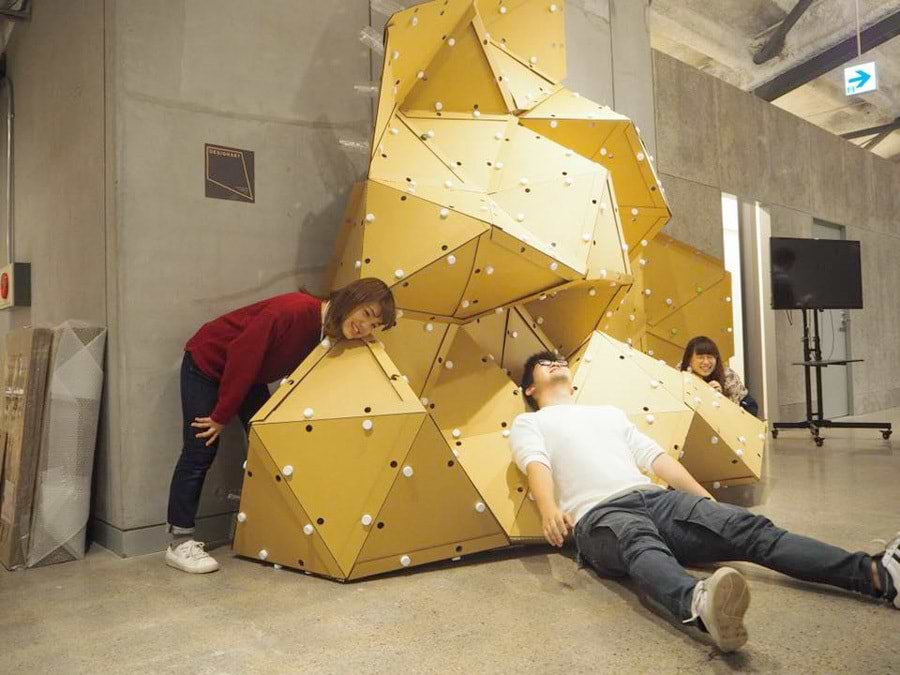
Monthly CX: Anyone can close or open the cap of a plastic bottle.
Takahashi: The act of screwing tight this cap of a plastic bottle is a user interface (UI) common all over the world. Anyone, regardless of age, can assemble the objects. Further research showed that Coca-Cola is sold all over the world. These two so-called ‘universal’ factors, the discovery of a universal act of human beings really accelerate the project.
Monthly CX: Universality, such as human instinct or the nature of things, is hidden within the objects. So first comes the joy of discovery than the act of inventing.
Takahashi: Yes. The universal psychology, such as an act that people do without even thinking, is what’s really interesting. I can see that the inventions I’ve come up with so far are based on that. I’m not really conscious of adhering to the rules, though. I know that the way things are created also change and evolve.
Monthly CX: Whatever you create using that universality, are there more things that are useful rather than things that are funny or make people laugh?
Takahashi: Both… I think. If it’s too serious, it’s not fun. I focus more on the fun or interesting aspects for objects that are supposed to be useful, and I focus more on the useful application for objects that are silly or funny.
If I’m going to invent something universal, then I want it to change the world for the better. So if I find something interesting, I first research any social issues that it may relate to. For example, Coca-Cola or McDonald’s are consumables that can be purchased in areas with a higher rate of poverty, which is a fact that I wasn’t aware of.
Monthly CX: Taking something that is criticized for its environmental load, such as the continuous use of plastic bottles, and turning it around just a little bit towards a positive direction does have an impact.
Takahashi: It does. Also, it’s interesting that you can stock universality and apply it to a future project. When I talk about an idea, such as using plastic bottle caps as a screw to build something, a client may react, “Maybe we could use that to do something together.” I really like it when that happens.
Monthly CX: Your vision makes the ‘customer’ in CX have a broader meaning.
Takahashi: Yes. The Japanese translation of ‘customer’ doesn’t have a positive image. It doesn’t have a good connotation; it’s like ‘someone who makes a purchase’.
Monthly CX: The Japanese word for ‘customer’ has an image of ‘someone who makes a purchase or spends money.’ But a customer also includes those who receive a service free of charge. It shouldn’t be just about a monetary exchange.
Takahashi: I’m also involved in a project called “Lab for Social Issues” (see the site in Japanese), and I heard the phrase ‘the Japanese people’s awareness towards citizenship’. One of the definitions of the word ‘citizen’ is ‘a voluntary or proactive member of a group’. I want my inventions to help increase the number of people who voluntarily do good deeds. Not that I’m a saint or anything! I just want to make a contribution that will bring out the good in people.
Monthly CX: So you’re saying that ‘CX’ is not ‘customer experience’, but the ‘C’ stands for ‘citizen’.
Takahashi: (Noticing that the first letter in ‘citizen’ is ‘C’) Oh…! Yes, of course, that’s right!
Monthly CX: That’s very interesting. Media hacking, the universal nature of man, and the definition of ‘citizens’. Thank you for covering such a diverse range of topics!
Takahashi: It was my pleasure.
